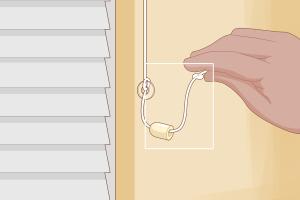Mastering the Art of Restringing Blinds: A Comprehensive Guide

-
Quick Links:
- Introduction
- Types of Blinds
- Tools and Materials Required
- Step-by-Step Guide to Restringing Blinds
- Common Issues and Solutions
- Case Studies
- Expert Insights
- Maintenance Tips for Longevity
- Conclusion
- FAQs
Introduction
Restringing blinds can seem like a daunting task, but with the right tools and guidance, it’s a manageable DIY project. Whether your blinds have snapped cords or have become tangled, knowing how to restring them will save you money and time. This comprehensive guide will take you through the entire process, ensuring your blinds are back in working order.
Types of Blinds
Before diving into the restringing process, it’s essential to understand the different types of blinds available. Each type has its unique mechanism and restringing method:
- Venetian Blinds: Horizontal slats that can be tilted for light control.
- Vertical Blinds: Suitable for large windows, featuring vertical slats.
- Roller Blinds: Made of a single piece of fabric that rolls up and down.
- Cellular Shades: Made of pleated fabric that forms honeycomb shapes for insulation.
Tools and Materials Required
Before starting, gather the necessary tools and materials:
- Replacement cord (specific to your blinds)
- Screwdriver
- Scissors
- Measuring tape
- Blinds repair kit (optional)
- Step stool (if needed)
Step-by-Step Guide to Restringing Blinds
Here’s a detailed guide to help you restring your blinds efficiently:
Step 1: Remove the Blinds
Carefully take down the blinds from the window frame. This may involve unscrewing brackets or unclipping them. Ensure you place them on a flat surface to avoid damage.
Step 2: Disassemble the Blinds
Remove the bottom rail and end caps. Take note of how the cords are threaded so you can replicate the setup later.
Step 3: Cut the Old Cords
Using scissors, cut the old cords at the top and bottom of the blinds. Be careful not to damage other components.
Step 4: Measure and Cut New Cords
Measure the length of the old cords and cut new ones accordingly, adding a few extra inches for adjustments.
Step 5: Thread the New Cords
Following the threading pattern from before, thread the new cords through the slats and the bottom rail. Ensure they move freely.
Step 6: Reassemble the Blinds
Replace the end caps and bottom rail. Double-check that all components are securely attached.
Step 7: Reinstall the Blinds
Carefully reinstall the blinds into their brackets, ensuring they are level and secure.
Common Issues and Solutions
While restringing blinds, you may encounter some common issues:
- Cords Getting Stuck: Ensure cords are threaded properly and not tangled.
- Blinds Won’t Lift: Check for obstructions or ensure cords are not frayed.
- Uneven Slats: Realign slats and ensure cords are pulled evenly.
Case Studies
To further illustrate the process, here are a couple of case studies:
Case Study 1: Residential Venetian Blinds
A homeowner faced issues with their Venetian blinds that had snapped cords. Using our guide, they successfully replaced the cords and restored functionality in under an hour.
Case Study 2: Office Vertical Blinds
An office manager dealing with several broken vertical blinds utilized our tips to restring multiple sets over a weekend, enhancing the workspace’s aesthetic and functionality.
Expert Insights
According to home improvement experts, regular maintenance is key to prolonging the life of your blinds. Simple steps include dusting and checking for wear on cords every few months.
Maintenance Tips for Longevity
Here are some maintenance tips to keep your blinds in top shape:
- Dust regularly with a microfiber cloth.
- Check cords for wear and replace as needed.
- Avoid pulling cords too hard to prevent breakage.
Conclusion
Restringing blinds is a straightforward process that can save you money and restore the functionality of your window treatments. By following this guide, you can tackle this DIY project with confidence.
FAQs
1. How often should I restring my blinds?
It depends on usage, but checking annually is a good practice.
2. Can I use any cord to restring my blinds?
It’s best to use cords designed specifically for your type of blinds to ensure compatibility.
3. What if my blinds are still tangled after restringing?
You may need to disassemble and re-thread them, ensuring to follow the original pattern.
4. Are there professional services available?
Yes, many home improvement stores offer professional repair services.
5. Can I restring blinds without removing them?
It’s challenging, but some methods allow for restringing while still mounted if you’re careful.
6. What tools do I need for restringing?
A screwdriver, scissors, measuring tape, and replacement cords are typically required.
7. How long does it take to restring blinds?
Most projects take between 30 minutes to 2 hours, depending on experience and complexity.
8. Are there any safety precautions to consider?
Always use caution when using sharp tools and ensure ladders or stools are stable when working at height.
9. Can I restring different types of blinds the same way?
No, each type of blind has its specific mechanism that requires a tailored approach.
10. Where can I buy replacement cords?
Most home improvement stores and online marketplaces offer replacement cords suitable for various blinds.
Random Reads
- How to wax wooden furniture
- Improve radio reception
- Increase microphone volume android
- Mastering dog taming breeding minecraft
- Ultimate guide to spring cleaning your room
- How to set speed dial on android
- How to record video on a pc
- How to record zoom meeting iphone ipad
- How to make your own clothing mods for the sims 4
- How to install ceiling drywall